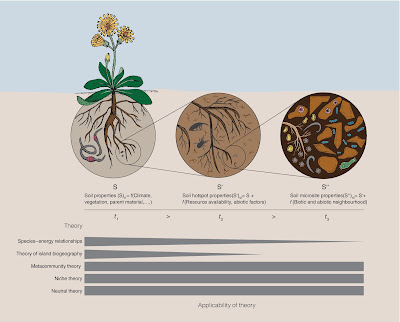Thakur et al., 2019
Soil is one of the most biodiverse terrestrial habitats. Yet, we lack an integrative conceptual framework for understanding the patterns and mechanisms driving soil biodiversity. One of the underlying reasons for our poor understanding of soil biodiversity patterns relates to whether key biodiversity theories (historically developed for aboveground and aquatic organisms) are applicable to patterns of soil biodiversity. Here, we present a systematic literature review to investigate whether and how key biodiversity theories (species–energy relationship, theory of island biogeography, metacommunity theory, niche theory and neutral theory) can explain observed patterns of soil biodiversity. We then discuss two spatial compartments nested within soil at which biodiversity theories can be applied to acknowledge the scale‐dependent nature of soil biodiversity.
Illustration of spatial compartments in the soil for studying soil biodiversity from micro‐ to macroorganisms. The properties of each compartment that potentially affect the respective biodiversity pattern are listed below the compartments. As we begin to zoom in from soil (S) to soil microsites (S″), the applicability of some biodiversity theories may also change (indicated by thickness of grey bars below the figure). Soil micro‐aggregates are coloured light brown in the S″ compartment; all organisms in S″ are either microorganisms or their predators (e.g. nematodes and protists). Note that microorganisms also can colonize micro‐aggregates as illustrated in S″. Since the temporal scale (t) also co‐varies with spatial scale (Wolkovich et al., 2014), the figure presents three different temporal scales (t1–t3) corresponding to the three spatial scales. f, function.
https://onlinelibrary.wiley.com/doi/full/10.1111/brv.12567
.











No hay comentarios:
Publicar un comentario